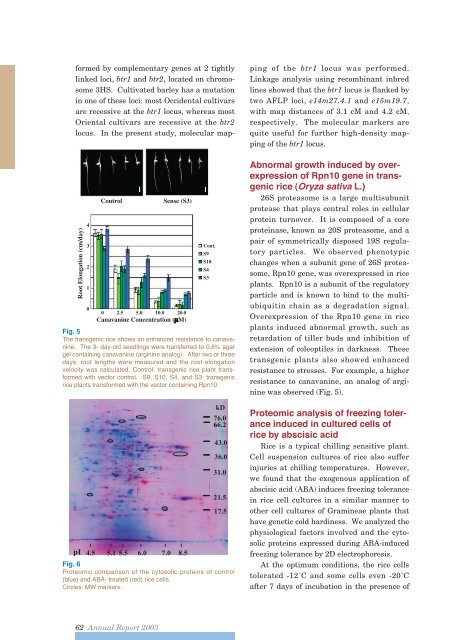Create successful ePaper yourself
Turn your PDF publications into a flip-book with our unique Google optimized e-Paper software.
Fig. 5The transgenic rice shows an enhanced resistance to canavanine.The 3- day-old seedlings were transferred to 0.8% agargel containing canavanine (arginine analog). After two or threedays, root lengths were measured and the root elongationvelocity was calculated. Control: transgenic rice plant transformedwith vector control. S9, S10, S4, and S3: transgenicrice plants transformed with the vector containing Rpn10.Fig. 6Proteomic comparison of the cytosolic proteins of control(blue) and ABA- treated (red) rice cells.Circles: MW markers.formed by complementary genes at 2 tightlylinked loci, btr1 and btr2, located on chromosome3HS. Cultivated barley has a mutationin one of these loci: most Occidental cultivarsare recessive at the btr1 locus, whereas mostOriental cultivars are recessive at the btr2locus. In the present study, molecular mappingof the btr1 locus was performed.Linkage analysis using recombinant inbredlines showed that the btr1 locus is flanked bytwo AFLP loci, e14m27.4.1 and e15m19.7,with map distances of 3.1 cM and 4.2 cM,respectively. The molecular markers arequite useful for further high-density mappingof the btr1 locus.Abnormal growth induced by overexpressionof Rpn10 gene in transgenicrice (Oryza sativa L.)26S proteasome is a large multisubunitprotease that plays central roles in cellularprotein turnover. It is composed of a coreproteinase, known as 20S proteasome, and apair of symmetrically disposed 19S regulatoryparticles. We observed phenotypicchanges when a subunit gene of 26S proteasome,Rpn10 gene, was overexpressed in riceplants. Rpn10 is a subunit of the regulatoryparticle and is known to bind to the multiubiquitinchain as a degradation signal.Overexpression of the Rpn10 gene in riceplants induced abnormal growth, such asretardation of tiller buds and inhibition ofextension of coleoptiles in darkness. Thesetransgenic plants also showed enhancedresistance to stresses. For example, a higherresistance to canavanine, an analog of argininewas observed (Fig. 5).Proteomic analysis of freezing toleranceinduced in cultured cells ofrice by abscisic acidRice is a typical chilling sensitive plant.Cell suspension cultures of rice also sufferinjuries at chilling temperatures. However,we found that the exogenous application ofabscisic acid (ABA) induces freezing tolerancein rice cell cultures in a similar manner toother cell cultures of Gramineae plants thathave genetic cold hardiness. We analyzed thephysiological factors involved and the cytosolicproteins expressed during ABA-inducedfreezing tolerance by 2D electrophoresis.At the optimum conditions, the rice cellstolerated -12˚C and some cells even -20˚Cafter 7 days of incubation in the presence of62 <strong>Annual</strong> <strong>Report</strong> <strong>2003</strong>













